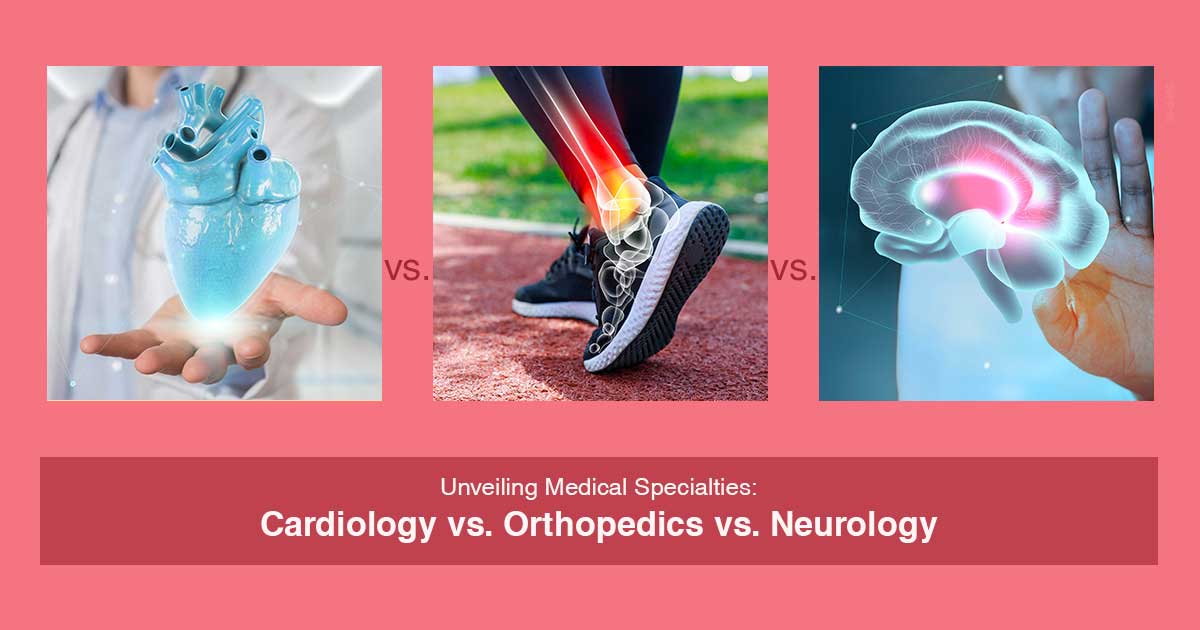Blog Detail


Unveiling Medical Specialties: Cardiology vs. Orthopedics vs. Neurology
10-04-2024

Medical science is a vast study concerned with the diagnosis, treatment and prevention of diseases and chronic bodily conditions. Specialisations like cardiology, orthopaedics and neurology are open for study after the successful completion of an MBBS (Bachelor of Medicine, Bachelor of Surgery) degree.
Cardiology is the field of medical science that is concerned with the health of the heart and the blood vessels. Orthopaedics is the medical branch designated for the health and correction of the deformities of bones, tendons, ligaments and muscles. Neurology is the branch of medical science that evolves with the testing, diagnosis and treatment of disorders and diseases related to the nervous system.
In this article, we shall further look at the core areas of study under each specialisation and the career prospects in each field.
Cardiology vs. Orthopedics vs. Neurology: Course Duration and Eligibility
Cardiology, orthopaedics and neurology are master’s specialisations open for students to enrol in after completing their MBBS degree. These post-graduate courses, collectively referred to as MD (with specialisations) are full-time 3-year programmes with extensive practical classes and hospital-serving internships.
The eligibility criteria for enrolling in MD.Cardiology, MD.Orthopedics and MD. Neurology is the successful completion of an MBBS degree with an aggregate score falling under the cut-off list published by the university.
Cardiology vs. Orthopedics vs. Neurology: Course Curriculum
Medical science lays the foundation stone for the health sector, the importance of the field is beyond explanations. The master's degree in medical science is extensively elaborate and in-depth. The course curricula for the mentioned specialisations at the master’s level are as follows:
Major subjects taught for the course of Cardiology are Fundamentals of cardiovascular diseases, Cardiac molecular biology, Cardiac biochemistry, Cardiac pharmacology, Cardiac anatomy, Cardiac physiology, Imagine techniques of the heart, Nuclear Cardiology, Preventive cardiology and epidemiology, Cardiac pathology, Cardiac microbiology, Pediatric Cardiology,, Coronary artery Diseases, Cardiac arrhythmias, Heart failure, Pericardial diseases, Congenital heart diseases, Rheumatic heart disease, Heart muscle diseases, Pulmonary thromboembolism and pulmonary hypertension, Systemic hypertension, Heart muscle diseases, Tumours of the heart, Geriatric heart diseases, Genetics, General anaesthesia, Traumatic heart disease, Non- Invasive techniques in cardiology, and Invasive cardiology.
Major subjects covered under Orthopaedics are Traumatology or General Orthopaedics, Infections and Tumours, Spine Anomaly, Sports Medicine, Amputation, Imaging (foot/ankle), Physical Anthropology, Applied Anatomy, Histology, Applied Radiology, Applied Dental Materials, Nutrition, Physical Anthropology, Child Psychology, Applied Physiology, Applied, Pathology, and Study of Biostatics.
The subject areas in Neurology are Developmental Neuroscience, Clinical Neuroscience, Computational Neuroscience, Molecular Neuroscience, Neurophysiology, Neurogenetics, Systems neuroscience, and Neuroimaging.
Cardiology vs. Orthopaedics vs. Neurology: Career Opportunities
The demand for medical science is always on the horizon and so does the career opportunities in the field.
Career options for students after opting for Cardiology:
- EKG technician: Works as a specially trained medical professional who tests the electrocardiogram tests in patients.
- Exercise physiologists: They are allied health professionals who train people with suitable physical exercise for preventing injuries and chronic health conditions.
- Cardiovascular technician: Performs surgical procedures like implantation of stents, pacemakers and more.
- Respiratory therapists: They are specialised healthcare practitioners trained for cardiopulmonary care.
- Medical sonographers: They are engaged in actively analysing sonographic images and giving valuable inputs.
- Cardiology consultant: Diagnoses and treats people with defects in the heart and blood vessels.
- Cardiac surgeon: After a thorough study of the diagnosed problem, the surgeon performs the necessary surgery to save the patient’s life.
Career options for students after opting for Orthopaedics:
- Orthopaedic Surgeon: Performs the necessary surgeries related to the disorders in bones, ligaments, joints, tendons and muscles.
- Clinical Associate: Involves in studying the case and providing valuable insights on clinical tests and requirements.
- Medical Consultant: Uses his/her subject expertise to diagnose and treat patients with medicines.
- Orthopaedic Professors: Engaged in teaching medical students at bachelor’s and master’s levels.
- Pediatric Surgeon: Performs surgeries for children (under the age of 18) for orthopaedics-related issues.
Career options for students after opting for Neurology
- Laboratory technician: Assists by engaging in technical works in the laboratory.
- Health educator: Engaged in taking classes, and seminars and spreading awareness among people on various issues.
- Pharmaceutical sciences manager: Performs experiments to find out new effective drugs without side effects for problematic diseases.
- Research scientist: Engaged in studying a concern and trying to find possible solutions.
- Clinical psychologist: Involves in diagnosing and treating mental and emotional disorders through various therapeutic techniques.
- Medical writer: Engaged in writing scientific documents in medical language.
- Physician assistant: Works as a licensed medical professional and provides care to patients.
In Short
Most often, medical science is considered a miracle for its precision and depth of study. As discussed in this article there is never any less complicated or less intricate functioning system when it comes to the medical science of the human body. Mastering these subjects is demanding of time, energy and dedication and so it is very important to choose a field of personal interest for the smooth sailing of course completion. Each field is of equal relevance and need of the hour. Career opportunities are multiple in every other field, especially in this era of rising demand for medical science. Mastering in medical science is an unending process as the journey of learning is a forever process and so students should research well before getting enrolled for specialisations for master’s.